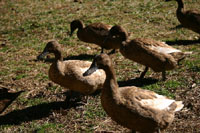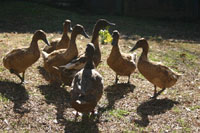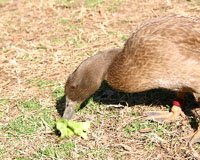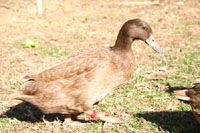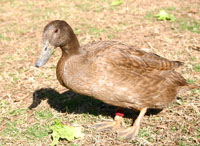
As spring and the close of our second year with ducks approaches, I should offer an update on our experiences. I apologize for its somewhat random nature, but that’s life with poultry. Or with anything else, really. Covered here are molting, a hawk attack, duck first aid, and a new house.
Molting
I found conflicting and inconsistent advvice on what to do about molting. Domestic ducks normally change their feathers once a year, and laying stops during this period as the ducks’ energy is directed to growing new plumage. One book advised force-molting by withholding food and water for a few days; this shocks the birds into losing their feathers and growing new ones. I questioned whether this was really necessary — shouldn’t they molt naturally? Other sources said they would. So I decided to wait and see what happened.
The ducks began molting in late May (which is effectively early summer here). Interestingly, the ducks that had been first to develop as ducklings were the first to molt as well. Molting proceeded very slowly, though; only Eddy actually completed her molt, and not until November. While they molted gradually, egg production dropped somewhat (see the production table). Saffy only replaced about half of her feathers, and she appears to have stopped laying entirely since at least early December — it may be that with old feathers, she needs more energy to keep warm and thus cannot lay eggs as well, or the two developments may be unrelated. We will have to wait and see when the weather warms up.
I have also read that domestic ducks do not always molt during their second year. (As I said, the advice is extremely contradictory.) So our experience may be normal. If they aren’t going into full molt by mid-June, though, I expect I will withhold food to force them to molt this year. Their feathers won’t hold them through another winter.
Hawk attack!
After our daughter was born in early September, one of us was home every day during the fall, and we began letting the ducks free-range in the yard most of the day. Unfortunately, a red-tailed hawk found them. The ducks had fought off juvenile hawks before with little trouble, but this was the mama hawk, who was as to the juveniles as Grendel’s mama was to Grendel. Polly very nearly became lunch, but Kathy happened to go outside just as the hawk was attacking, and Polly escaped with a talon scratch on her lower back and a slight limp that lasted several weeks. She seems to be walking fine now, though.
Duck first aid
We had to learn duck first aid last summer — very quickly! — but not because of predators. We initially banded the ducks with different colors of velcro so that we could tell them apart. Last spring we bought them wire leg bands; we had to buy bags of 50 in each color, but they weren’t too expensive and we figured we’d use them eventually. The bands were supposedly the correct size for Campbells, and they seemed to fit fine when we put them on.
Apparently we, and/or the people who sold us the bands, were wrong. In late July we saw that one duck, Francie, was limping, and when we examined her we discovered that her band was cutting into her leg. We cut it off and the wound underneath began spurting blood: the band had been holding the wound closed, and when we removed it the thin layer of skin broke. Kathy staunched the bleeding with cotton gauze, which took nearly 20 minutes, and we put antiseptic ointment on the wound and bandaged it with nonstick pads and more gauze.
Then came the interesting part: keeping her confined and clean until the wound healed. She couldn’t be out in the yard with a leg wound, and she certainly couldn’t swim. So we used a hard-sided cat carrier, lined with newspaper, as an infirmary for three days until the wound had healed over, changing the bandage twice a day. Francie was extremely unhappy about being confined, but she’d have been far less happy if her leg had gotten infected, because that would have been the end of Francie; we’re not going to pay vet bills for the ducks. (You have to draw a line somewhere.) But she was no worse for the wear, and the wound had completely healed in a week or so. They seem to be quite resilient.
A few of the other ducks had indentations or scrapes in their legs from the bands (though no open wounds), so we removed all the bands and replaced them with velcro again. The velcro gets dirty and has to be replaced a few times a year, but at least it’s safe. I may eventually try a larger size band now that I have a better idea how they ought to fit, but I suspect that wire leg bands simply aren’t designed for long-term wear. The ends of the wire coils were quite sharp, and I’d be afraid that on a longer band the points might injure the ducks. If I get ambitious and have more free time, maybe I’ll design something better.
A side note: our cat Mao has often watched the ducks out the window with a look on his face that says you’re lunch if I can get outside! When we carried Francie through the living room on the way to her temporary infirmary, though, and Mao was confronted for the first time with an adult duck quacking loudly and struggling to flap her wings, he took off at a run and hid under the couch for half an hour. I suppose this is funnier if you know Mao, but it confirmed our assumption that we had nothing to worry about from stray cats.
Moving day
Last summer, when it became clear that we were going to be living in our present house for several more years, we decided that the under-the-deck duck pen had to go. It was leaky, inconvenient, and not technically within local livestock ordinances. So I designed and built a smaller but sturdy and safe duck house with an attached run. Photos and construction details are on a separate page.
The ducks, sadly, were not immediately appreciative of my efforts. They are creatures of habit, as I’ve mentioned before, and while they’re easy enough to manage if you stick to their routine, God help you if you want to try something new. Herding them into the new house was a two-person job for several days, even with plywood propped up to guide them into the door. After a week or so I was able to herd them in by myself, but even now (more than three months later) one duck, usually Bubble, refuses to cooperate and runs round the back of the house instead of going in the door. Then the only thing to be done is to drive the other six back out, let them regroup, and try again. It is happening less and less frequently, but I’m considering building a short fence between the corner of the duck house and a nearby tree to cut off her escape. If we plant hostas along it, at least it will look better than the plywood.
Duck linguistics
And finally, a brief note about ducks’ ability to understand spoken English (or, I assume, any other human language). Ours seem consistently to recognize three words: pen, bedtime, and lettuce. “Lettuce” is obvious. “Pen” is their grazing pen, where they go in the morning, and “bedtime” (or sometimes just “bed”) is their house, where they go at night. I had assumed that they went to the correct place in morning and evening merely out of habit, but twice in the past month, Kathy or I have made the mistake of saying “go to your pen” when we meant “go to bed” — and both times, they immediately peeled off and headed into their grazing pen. Both times, Eddy was at the lead. I figure with things like this that once is a fluke, twice is a coincidence, and three times is a pattern. If it happens again, I may really have to think about breeding that duck.
Photos
Click any of the photos below for a larger image.
